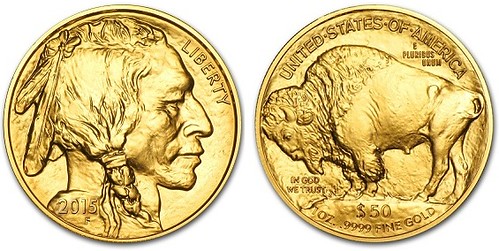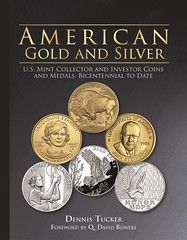
PREV ARTICLE
NEXT ARTICLE
FULL ISSUE
PREV FULL ISSUE
AUTHOR'S NOTES: AMERICAN GOLD AND SILVERDennis Tucker writes: Last week Dave Bowers wrote about the “how” of my book, American Gold and Silver. In response I’ve followed up with an article on why I wrote the book.
Thanks. Here's an excerpt from Dennis' November 23, 2015 Coin Update article, which includes multiple images of sample
pages. -Editor

American Gold and Silver: U.S. Mint Collector and Investor Coins and Medals, Bicentennial to Date is the third book in a trilogy of Whitman Publishing volumes exploring the modern silver, gold, and platinum coins and medals of the U.S. Mint. The first was American Silver Eagles, by retired Mint chief engraver John M. Mercanti with numismatist Michael Standish. The second was American Gold and Platinum Eagles, by retired Mint director Edmund C. Moy. Those two books covered the ins and outs of our nation’s biggest bullion coin programs: the American Eagles. American Gold and Silver covers “everything else”—focusing first on the American Arts Commemorative Series of the early 1980s, which laid the foundation for the successes that followed (including the American Eagles).
America’s relationship with silver and gold didn’t start in the 1980s, of course. Chapter 1 sets the stage with a brief history of Man’s ancient fascination with the precious metals. This leads into the British colonial era, wherein mercantilism and other economic and legal forces affected (and largely restricted) the circulation of gold and silver in America. A discussion of the coinage of the U.S. Mint starts in the 1790s and leads to the mandated end of circulating gold in 1933. The “villain” in this scenario (or hero, depending on your viewpoint) is President Franklin Roosevelt, with his famous Executive Order 6102, under which millions of dollars’ worth of gold coins were surrendered to the Federal Reserve. The 30-plus-years stretch of gold being illegal was finally broken in 1974, when President Gerald Ford retracted Roosevelt’s orders and made gold legal to own again. From this came a period of robust debate and study on the federal level—leading, as noted above, to the American Arts gold medal experiment and, ultimately, to the birth of today’s hugely successful American Eagles. Not long before that, silver went through its own turbulent period, rising in value worldwide until the United States was forced to remove it from all circulating coinage. As I note in chapter 2, it’s interesting that gold and silver have left the realm of day-to-day money, but gold is now more readily and legally accessible to the average American than ever in the past. In recent years the U.S. Mint has continued to innovate and develop new bullion programs. They are part of America’s rich heritage. They occupy the final pages of a national story still being written, and they deserve our study—hence this new book. The country’s first 24-karat gold coins, in the American Buffalo series, are herded together in chapter 5. The beautiful First Spouses, which include some of the rarest of modern U.S. coins, are assembled in chapter 6. Silver is given the spotlight in chapter 7, with the massive five-ounce coins of the America the Beautiful series. Other chapters focus on other silver and gold coins and medals, mostly dating from the Bicentennial to today. The American Eagles are without a doubt the most popular of U.S. bullion coins. Collectors and investors have bought more than 350 million one-ounce American Silver Eagles since the modern bullion program started in 1986, and more than 43 million gold and platinum Eagle coins in various sizes and formats. However, the U.S. Mint’s other silver and gold programs—those explored in this book—have also made their mark and won their share of enthusiasts. Each series has its own special charm, and it’s notable that six of the coins cataloged in American Gold and Silver have been ranked among the “100 Greatest U.S. Modern Coins.” Since 2006 collectors and investors have bought nearly 3 million gold coins of the American Buffalo series; a testament, in part, to the uniquely American artistry of their design. Other programs that might not sell in the millions hold the potential for hidden gems—“sleepers” of low mintage and high aesthetic appeal, waiting to be discovered by the mainstream of the hobby. The entire mintage of First Spouse bullion coins sold since 2007—accounting for some 175,000 ounces of gold—is eclipsed by the output of any single year, even the least active, in the American Gold Eagle program. And yet, for collectors, their very scarcity makes them far more desirable than their more common cousins. American Arts gold medallions, honoring some of the nation’s most popular artists, have seen attrition over the years that makes even the most common pieces much scarcer than their mintages suggest. And the Mint’s other silver and gold medals and coins commemorate great Americans (Martha Washington, Benjamin Franklin, Teddy Roosevelt), historic places (Gettysburg, Mount Rushmore), significant events (the Bicentennial of Independence, 9/11), and other national subjects that make their appeal and their importance timeless. American Gold and Silver is the first book to systematically study each of the Mint’s recent bullion-related coinage and medallic programs. It was written to be an overview for the newcomer to these series—the collector who wants a detailed but engagingly readable education in history, rarity levels, popular varieties, and market values. It’s also a book for the longtime collector who wants a single-source reference: a guide not to be read once and then shelved, but to be kept handy for frequent visits and consultations. It’s a textbook for the serious numismatist who wants a behind-the-scenes view of the intricacies of design, production, distribution, and other technical and artistic factors. And for the investor this book introduces and explains the lure of numismatics—the art and science of the hobby of collecting coins—adding another aspect to the desirability of these interesting bullion issues. To read the complete article, see:
To read the earlier E-Sylum article, see:
Wayne Homren, Editor The Numismatic Bibliomania Society is a non-profit organization promoting numismatic literature. See our web site at coinbooks.org. To submit items for publication in The E-Sylum, write to the Editor at this address: whomren@gmail.com To subscribe go to: https://my.binhost.com/lists/listinfo/esylum All Rights Reserved. NBS Home Page Contact the NBS webmaster 
|
